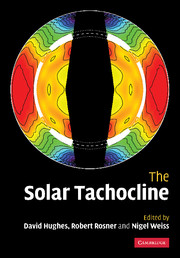Book contents
- Frontmatter
- Contents
- Contributors
- Preface
- I Setting the scene
- II Observations
- III Hydrodynamic models
- IV Hydromagnetic properties
- V Instabilities
- 10 Global MHD instabilities of the tachocline
- 11 Magnetic buoyancy instabilities in the tachocline
- 12 Instabilities, angular momentum transport and magnetohydrodynamic turbulence
- VI Dynamo action
- VII Overview
- Index
11 - Magnetic buoyancy instabilities in the tachocline
Published online by Cambridge University Press: 21 August 2009
- Frontmatter
- Contents
- Contributors
- Preface
- I Setting the scene
- II Observations
- III Hydrodynamic models
- IV Hydromagnetic properties
- V Instabilities
- 10 Global MHD instabilities of the tachocline
- 11 Magnetic buoyancy instabilities in the tachocline
- 12 Instabilities, angular momentum transport and magnetohydrodynamic turbulence
- VI Dynamo action
- VII Overview
- Index
Summary
It is natural to associate the tachocline with the region of generation of a strong toroidal field by the winding-up of a weaker poloidal component. Here I discuss the break-up and subsequent escape of such a field via magnetic buoyancy instabilities. I consider the different modelling approaches that have been employed and discuss which have the most relevance in a solar context.
Introduction
For many years, a controversial issue of solar magnetism has been that of the location of the site (or sites) of the generation and storage of the Sun's predominantly toroidal magnetic field, which eventually escapes and rises to the surface, leading to active regions and, ultimately, to much of the exotic magnetic behaviour observed in the photosphere, chromosphere and corona. For two rather different reasons, the idea had been put forward that the bulk of the toroidal field must be stored either at the base of, or just beneath, the convection zone. From estimates of the rise times of magnetic flux tubes through the convection zone, Parker (1975) argued that the dynamo must operate only in the ‘very lowest levels of the convective zone’. Golub et al. (1981) (see also Spiegel & Weiss 1980) proposed a similarly deep-seated layer of toroidal field, but from arguments based instead on the expulsion of magnetic fields by convective motions. The discovery of the tachocline by helioseismology provides probably the most compelling evidence for pinning down the location of the solar toroidal field.
- Type
- Chapter
- Information
- The Solar Tachocline , pp. 275 - 298Publisher: Cambridge University PressPrint publication year: 2007
- 25
- Cited by

